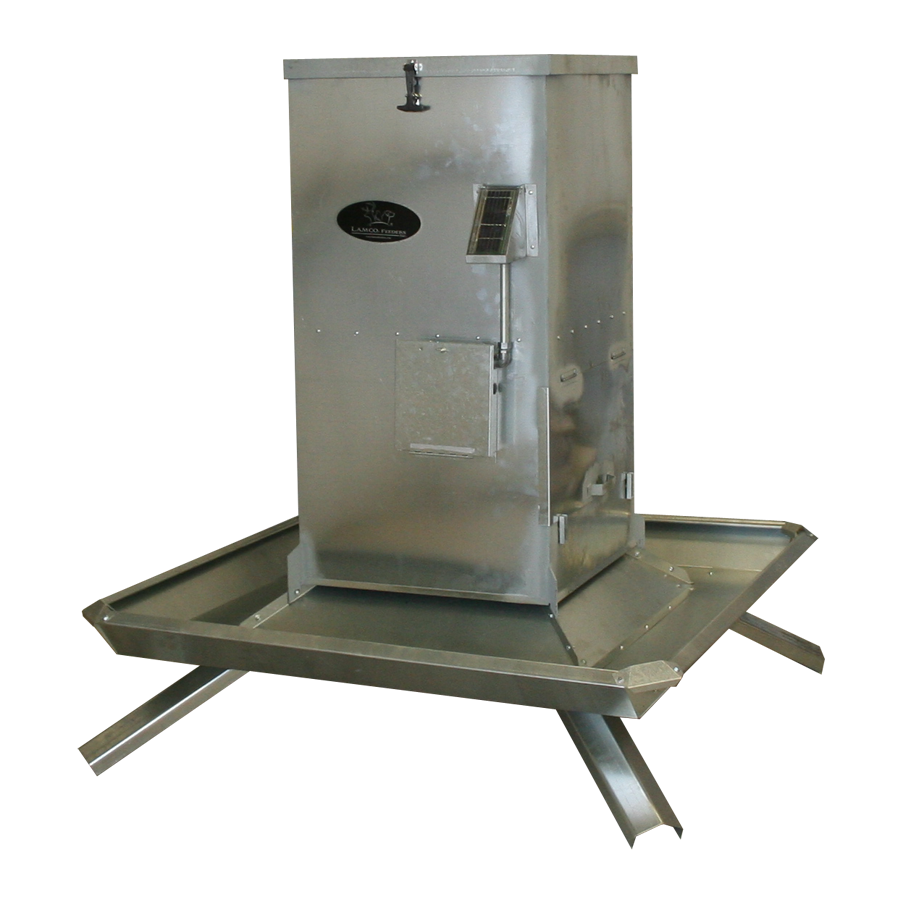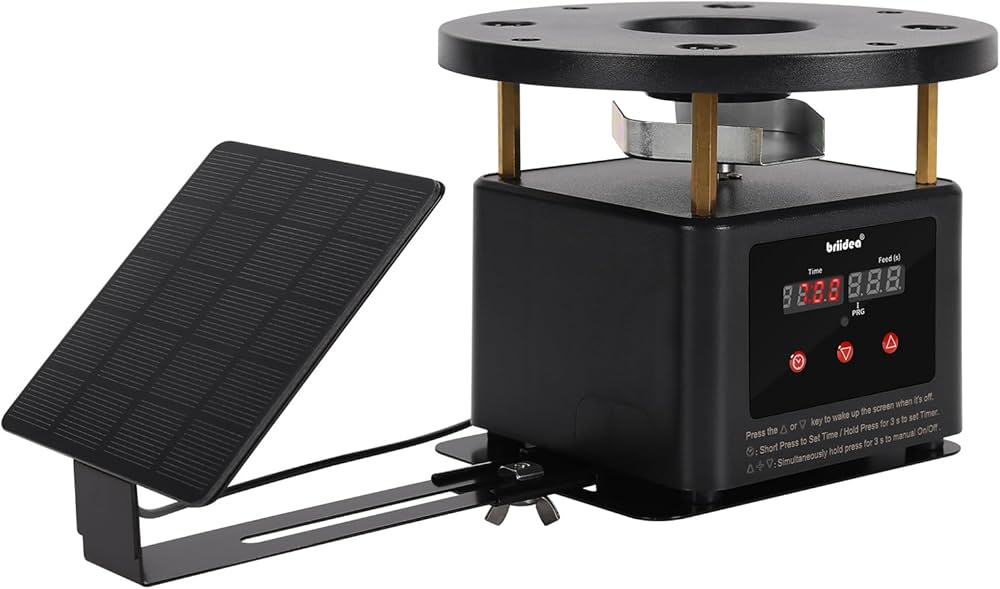Automatic Deer Feeder With Timer: Boost Your Hunting Success
Automatic deer feeders with timers are a boon for wildlife enthusiasts. They make feeding deer easy and efficient.
Imagine having the ability to feed deer without being physically present. An automatic deer feeder with a timer does just that. It helps maintain a regular feeding schedule, ensuring deer come back to your spot. This is especially useful for hunters and nature photographers.
Consistent feeding attracts deer and keeps them healthy. Such feeders also reduce waste and save time. In this blog, we will explore the features and benefits of using an automatic deer feeder with a timer. You will learn why this tool is essential for anyone serious about managing wildlife. Let’s dive in and discover more!

Credit: www.outdoorsforless.com
Introduction To Automatic Deer Feeders
Automatic deer feeders are essential for hunters and wildlife enthusiasts. They help in attracting deer to specific locations. These feeders dispense food at scheduled times. This ensures consistent feeding patterns. It leads to better deer management and hunting opportunities.
Benefits For Hunters
Using an automatic deer feeder with a timer offers several advantages:
- Ensures regular feeding times
- Attracts deer to a specific spot
- Reduces the need for manual feeding
- Helps in monitoring deer activity
Hunters benefit from predictable feeding patterns. This allows for better planning and hunting strategies. The feeder also supports deer health by providing consistent nutrition.
How They Work
An automatic deer feeder with a timer operates on a simple mechanism:
- Fill the feeder with deer feed.
- Set the timer to desired feeding intervals.
- The timer triggers the dispenser at set times.
- Deer are attracted to the feed at these times.
These feeders typically run on batteries or solar power. They are designed to withstand outdoor conditions. Some models even come with remote controls. This allows hunters to adjust settings from a distance.
Here is a comparison of different power sources:
| Power Source | Pros | Cons |
|---|---|---|
| Battery | Easy to replace, reliable | Needs regular replacement |
| Solar | Eco-friendly, low maintenance | Dependent on sunlight |
Understanding how these feeders work helps in selecting the best model. It ensures maximum efficiency and convenience for hunters.
Choosing The Right Feeder
Choosing the right automatic deer feeder with a timer can be overwhelming. There are many factors to consider to ensure it meets your needs. In this section, we will cover key aspects to help you make an informed decision.
Capacity Considerations
The capacity of your deer feeder is crucial. It determines how much feed it can hold and dispense. A larger capacity means less frequent refilling. This is ideal for busy schedules.
Consider the following:
- Small Feeders: Hold up to 50 pounds. Suitable for small herds.
- Medium Feeders: Hold between 50-150 pounds. Good for moderate activity.
- Large Feeders: Hold over 150 pounds. Best for large herds or frequent feeding.
Durability And Materials
Durability is essential for a deer feeder. It needs to withstand various weather conditions and wildlife interactions. Look for feeders made from high-quality materials.
Common materials include:
| Material | Durability |
|---|---|
| Plastic | Lightweight and resistant to rust. Less durable against animals. |
| Metal | Heavy-duty and rust-resistant. More durable but heavier. |
| Polyethylene | Very durable and resistant to UV rays. Ideal for long-term use. |
Choose a feeder that balances durability and ease of use. This ensures it lasts longer while providing reliable feeding.
Importance Of A Timer
The importance of a timer in an automatic deer feeder cannot be overstated. Timers ensure that deer receive food at consistent times. This consistency helps create a reliable feeding pattern. It also makes deer feel safe and secure. Consistency in feeding times can lead to healthier deer populations.
Consistent Feeding Times
Consistent feeding times help to establish a routine for deer. They will know when to expect food. This helps in attracting deer to the same spot daily. Consistency also reduces the stress on deer as they don’t need to search for food. A predictable food source makes deer feel secure. This can lead to more frequent visits and longer stays at the feeder.
Energy Efficiency
An automatic feeder with a timer is energy-efficient. Timers allow you to control the feeding times precisely. This means the feeder does not run unnecessarily. It saves battery life and reduces the need for frequent maintenance. Efficient energy use is beneficial for both the feeder and the environment.

Credit: africa-ird.org
Setting Up Your Deer Feeder
Setting up your automatic deer feeder with a timer is crucial for attracting deer. Proper setup ensures the feeder works efficiently, providing a consistent food supply. This guide will help you set up your deer feeder in the best way possible.
Ideal Locations
Choose a spot where deer frequently visit. Look for clearings near water sources or deer trails. Avoid placing the feeder too close to roads or human activity. It should be in a quiet, secluded area. This will make the deer feel safe.
Consider the terrain. The ground should be level and firm. This helps keep the feeder stable. Make sure the area has good visibility. Deer need to see the feeder from a distance.
Assembly Tips
Read the instructions carefully. Gather all parts before starting. Check if you need any tools. Most feeders require basic tools like a screwdriver. Lay out all pieces in order.
Start with the base. Attach the legs securely. The base must be sturdy. Next, assemble the hopper. This is where the feed is stored. Make sure all bolts and screws are tight.
Install the timer. Follow the manufacturer’s instructions. Set the timer to release feed at specific times. Consistent feeding times attract more deer. Finally, test the feeder. Ensure it works properly before filling it with feed.
Programming The Timer
Setting up your automatic deer feeder with a timer can greatly improve your hunting success. A well-programmed timer ensures that feed is dispensed at the right times, attracting more deer to your location. Let’s explore how to program the timer effectively.
Time Intervals
The first step is to set the time intervals for feeding. This determines how often the feeder releases food. Here’s a simple guide:
- Morning: 6 AM to 7 AM
- Midday: 12 PM to 1 PM
- Evening: 5 PM to 6 PM
These intervals align with deer activity patterns. Use the timer to program these times for consistent feeding. Ensure the intervals are not too close together to prevent overfeeding.
Seasonal Adjustments
Deer behavior changes with the seasons. Adjust your feeder timer accordingly:
| Season | Feeding Times |
|---|---|
| Spring | 6 AM, 12 PM, 6 PM |
| Summer | 5 AM, 11 AM, 7 PM |
| Fall | 7 AM, 1 PM, 5 PM |
| Winter | 8 AM, 2 PM, 4 PM |
Adjusting the timer ensures that deer visit your feeder regularly. In spring and summer, they are more active early in the morning and late in the evening. In fall and winter, they tend to feed during the day.
Programming your feeder’s timer is essential for attracting deer. Set the right intervals and adjust for seasons. This will keep your feeder effective all year round.
Maintaining Your Feeder
Maintaining your automatic deer feeder with a timer is crucial. It ensures the feeder works well and lasts longer. Regular maintenance prevents issues and keeps the deer coming back.
Cleaning Routine
Start by emptying the feeder. Remove old feed and debris. Use a brush to scrub the inside. Rinse with water and let it dry completely. Clean the timer area gently. Avoid water contact with electronic parts. Wipe with a dry cloth instead.
Replacing Parts
Check the feeder for worn or damaged parts. Replace broken components promptly. Look for cracks in the hopper or broken spinners. Ensure the timer works correctly. If it malfunctions, consider getting a new one. Regular part checks keep your feeder in top shape.
Safety Tips
Ensure the timer is set correctly to avoid overfeeding. Place the feeder in a safe, accessible location. Regularly check for any damage or malfunctions.
Ensuring the safety of both animals and humans is crucial. Here are some essential safety tips to consider.Preventing Animal Damage
Position the feeder in a secure location. This helps avoid unwanted animal interference. Use sturdy materials to protect the feeder. This makes it harder for animals to damage it. Check the feeder regularly for any signs of wear. Replace any damaged parts immediately.Human Safety
Always turn off the feeder before maintenance. This prevents accidental injuries. Wear gloves and protective gear while handling the feeder. This keeps you safe from sharp edges. Follow the manufacturer’s instructions closely. This ensures proper and safe use. Keep children away from the feeder. This prevents accidental harm. By following these tips, you can enjoy using your automatic deer feeder safely. “`Maximizing Hunting Success
For hunters, success often depends on timing and strategy. An automatic deer feeder with a timer can be a game-changer. These devices help hunters plan and execute their hunts with precision. They offer consistent feeding schedules, which attract deer and keep them in the area.
Understanding deer patterns and strategic feeding times can greatly increase hunting success. This section will explore how these elements work together to create a more effective hunting experience.
Tracking Deer Patterns
Deer have specific habits and routines. Learning these patterns is crucial. An automatic feeder can help track these movements. By monitoring when deer visit the feeder, hunters can gather valuable data. This information helps in predicting future behavior.
Trail cameras placed near feeders capture footage of deer activity. This visual data provides insights into their movement patterns. Knowing these patterns allows hunters to plan their hunts more effectively.
Strategic Feeding Times
Feeding times play a vital role in attracting deer. An automatic feeder with a timer allows precise control over feeding schedules. Setting the feeder to dispense food at specific times keeps deer coming back regularly.
Morning and evening are ideal feeding times. Deer are most active during these periods. By setting the feeder to release food at these times, hunters can increase their chances of sighting deer. Consistent feeding schedules also create a routine for the deer, making them more predictable.
In conclusion, using an automatic deer feeder with a timer can enhance hunting success. By tracking deer patterns and setting strategic feeding times, hunters can create a more effective hunting strategy. This approach leads to better results and a more rewarding hunting experience.
Common Issues And Troubleshooting
Automatic deer feeders with timers are great for wildlife management. Yet, they can have issues. Knowing common problems helps keep your feeder working well.
Battery Problems
Batteries are crucial for automatic feeders. A dead battery stops the feeder from working. Check the battery often to avoid issues.
- Low Battery Power: The feeder may not dispense feed properly. Always use a new or fully charged battery.
- Corrosion: Battery terminals may corrode over time. Clean them with a brush and baking soda solution.
- Loose Connections: Ensure battery connections are tight. Loose wires can cause power issues.
Regular battery checks can prevent many problems. Use a voltmeter to check battery health.
Clogged Feeders
A clogged feeder can ruin your feeding schedule. Debris or moisture can block the feeding mechanism.
- Wet Feed: Moisture can make feed sticky. Keep the feeder dry and use waterproof covers.
- Debris: Sticks, leaves, or other debris can clog the feeder. Clean the feeder regularly to remove any blockages.
- Feed Size: Make sure the feed size matches the feeder’s specifications. Large chunks can cause clogs.
Keeping the feeder clean is key. Use a brush to clean the dispenser and check for any stuck debris.
Addressing these common issues ensures your automatic deer feeder works well. Regular maintenance is essential.

Credit: shop.lamcofeeders.com
Frequently Asked Questions
What Is An Automatic Deer Feeder With Timer?
An automatic deer feeder with a timer is a device that dispenses feed at set intervals. It helps attract and nourish deer.
How Does A Deer Feeder Timer Work?
A deer feeder timer controls when and how often feed is released. It ensures consistent feeding times.
Why Use An Automatic Deer Feeder?
Using an automatic deer feeder ensures regular feeding times. It attracts deer and helps monitor their patterns.
Can I Customize Feeding Schedules?
Yes, most automatic deer feeders allow you to set custom feeding schedules. This helps match the deer’s natural habits.
Conclusion
An automatic deer feeder with a timer simplifies feeding routines. It ensures deer receive food on a consistent schedule. This tool helps maintain wildlife health and supports hunting strategies. Easy to set up and use, it saves time and effort.
Consider investing in one for a reliable feeding solution. Enjoy the benefits of a stress-free feeding process and healthier deer. This feeder is a practical addition for any wildlife enthusiast.





